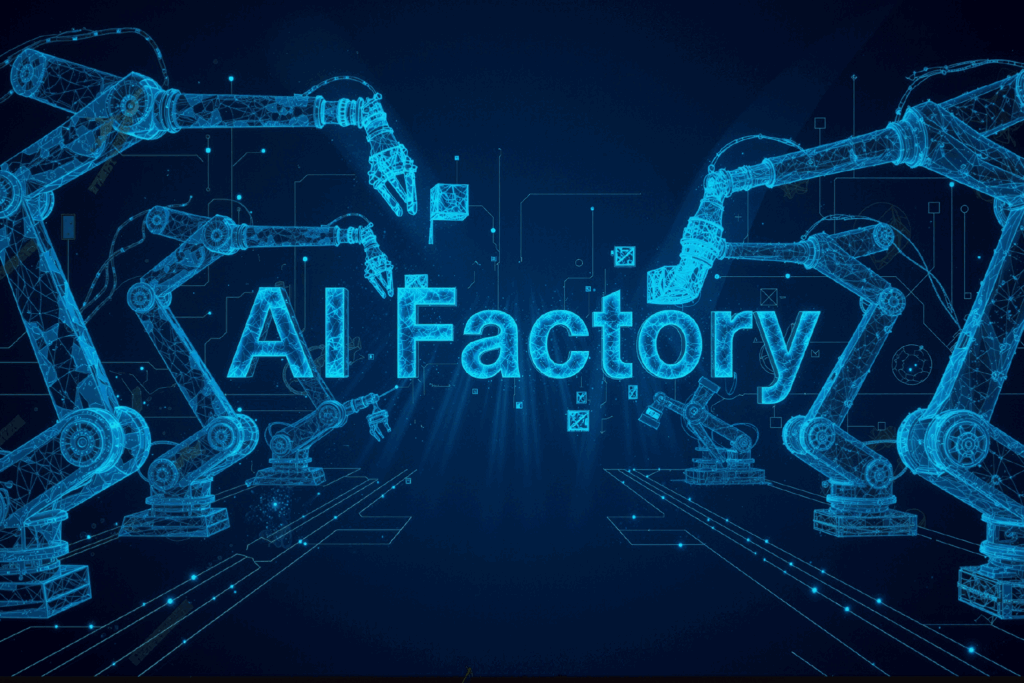If Industry 4.0 revolutionized physical production, the AI Factory revolutionizes the production of intelligence, unifying data, automation, and models to create value at scale.
In a global landscape increasingly dominated by Artificial Intelligence (AI), the ability to innovate and compete requires more than isolated machine learning, deep learning , or generative AI projects.
These technologies are part of the same spectrum within AI, and the challenge now is not to adopt isolated tools, but to orchestrate the entire intelligence production chain. A dedicated infrastructure for continuous production is needed: the AI Factory .
An AI Factory is an orchestrated and automated environment designed to accelerate the creation, training, deployment, and management of AI models at scale, operating like an industrial assembly line. Where in a traditional factory the raw material is physical components, in an AI Factory the "raw material" is data , and the "final product" is a deployed AI service or agent that generates business value.
The success of an AI Factory is based on automating the AI lifecycle , ensuring that models continuously adapt, evolve, and maintain their market relevance.
The 3 fundamental phases of an effective AI Factory
For intelligence production to be scalable and reliable, the AI Factory must manage a continuous flow that covers all stages, from data to decision.
1. Ingestion and organization (The raw material):
- This phase is dedicated to collecting raw data from operating systems (APIs, files), transforming them into clean and reliable sources.
- It involves the unified integration of data from different systems and its organization into architectures such as Lakehouse and Data Warehouse .
- This pillar is crucial because strategic decisions based on incomplete or outdated data create vulnerabilities.
2. Automation and orchestration (The assembly line):
- AI models and .
- It uses skills and LLMs ( Large Language Models ) — such as Gemini, GPT-4, or Skyone Studio — to create agents capable of planning, executing actions, and making context-based decisions.
- This step enhances productivity by allowing AI to understand human problems and interpret commands accurately.
3. Consumption and publication (The final product in use):
- The intelligence generated by the agents is made available in valuable destinations, such as Business Intelligence (BI) , chatbots , or autonomous workflows.
- It ensures that the results of the AI process are consumed in real time and in a practical way, strengthening governance and security.
Read also: Intelligent operations: the evolution of Industry 4.0 with applied AI
Why AI Factory is a strategic imperative
In today's market, where innovation is measured by speed, the AI Factory solves some of the biggest bottlenecks faced by executives and IT professionals:
- Talent shortage: AI Factory automates development steps, reducing reliance on lean internal teams and freeing up specialists for more strategic projects.
- Accelerating innovation: with the production line established, the time to market AI-based products is drastically reduced.
- Governance and compliance: well-structured models ensure that AI creation is aligned with rigorous audit and compliance requirements, such as LGPD and ISO 27001.
- Unlimited scalability: business growth cannot be hindered by legacy IT infrastructure. An AI Factory operates with on-demand resources, ensuring continuous performance, even during peak usage.
Practical examples: who already operates as an AI Factory
AI Factory is not just theory. Major global market leaders are already using this approach to maintain a competitive edge.
| amazon | Netflix | Tesla |
| It uses an AI Factory approach to power its recommendation engines, Alexa voice assistant, and logistics optimization. | It applies AI Factory principles to personalize content recommendations and optimize streaming quality. | It uses an AI Factory to continuously improve its autonomous driving software using data collected from its fleet of vehicles. |
The 5 steps to building your own AI Factory (The framework)
Solid companies anticipate and strengthen themselves by treating security and innovation as strategic pillars. Building an AI Factory follows a maturity cycle, divided into five essential stages:
- Democratize: ensure that data from production systems is accessible and usable.
- Integrate: perform the ingestion and manipulation of raw data.
- Transform: process, refine, and organize the data into ready-to-use databases ( Prepared DBs ) for AI use.
- Automate: Develop and orchestrate the AI Agents that will use this data.
- Make available: publish the final result to the Destinations (BI, Chat, Autonomous Flows) where the value will be consumed.
Conclusion: the product that enables your AI Factory
The path to success in the AI age lies in adopting an AI Factory : a continuous, efficient, and governed production line. The complexity of orchestrating data from hundreds of systems, managing Large Language (LLMs), and ensuring accurate automation is what prevents many companies from moving forward. This is where Skyone Studio .

Skyone Studio product interface — Reproduction: Skyone
Skyone Studio is a unified product that delivers the framework for your AI Factory. It not only integrates your data from over 400 different systems with its powerful iPaaS , but also organizes this mass of information in your Lakehouse (Data Lake and Data Warehouse).
With this solid database, Studio enables intelligent automation through the creation of AI Agents that plan and execute actions autonomously, especially enabled by Generative AI (GenAI), using advanced models and pipelines that allow the creation and orchestration of these agents. Finally, it makes this intelligence available for consumption across all communication and BI channels of your business.





